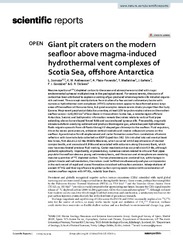| dc.contributor.author | Somoza, L. | |
| dc.contributor.author | Andreassen, Karin Marie | |
| dc.contributor.author | Plaza-Faverola, Andreia | |
| dc.contributor.author | Medialdea, T. | |
| dc.contributor.author | Gafeira, J. | |
| dc.contributor.author | González, F. J. | |
| dc.contributor.author | Dickens, G. R. | |
| dc.date.accessioned | 2025-01-30T11:42:39Z | |
| dc.date.available | 2025-01-30T11:42:39Z | |
| dc.date.issued | 2025-01-24 | |
| dc.description.abstract | Massive injection of <sup>13</sup>C depleted carbon to the ocean and atmosphere coincided with major environmental upheaval multiple times in the geological record. For several events, the source of carbon has been attributed to explosive venting of gas produced when magmatic sills intruded organic-rich sediment. The concept mostly derives from studies of a few ancient sedimentary basins with numerous hydrothermal vent complexes (HTVCs) where craters appear to have formed across large areas of the seafloor at the same time, but good examples remain rare in strata younger than the Early Eocene. We present geophysical data documenting at least 150 large (km-scale) craters on the modern seafloor across ∼148,000 km2 of Scan Basin in the southern Scotia Sea, a remote region offshore Antarctica. Seismic and bathymetric information reveals the craters relate to vertical fluid pipes extending above dome-shaped forced folds and saucer-shaped igneous sills. Presumably, magmatic intrusions deform overlying sediment and produce thermogenic gas, where buoyant hydrothermal fluids migrate upwards from sill flanks through V-shaped gas chimneys to the seafloor. Fluid expulsion, driven by excess pore pressure, enhances vertical conduits and creates collapse structures on the seafloor. Age estimates for sill emplacement and crater formation come from correlations of seismic reflectors with bore hole data collected on IODP Expedition 382. Sills intruded into sediment at least two times, first about 12–13 Ma (Middle Miocene), which occurred with deep intrusions of stacked composite sills, and once about 0.9 Ma and associated with volcanism along Discovery Bank, which may have reactivated previous fluid venting. Crater reactivation has occurred since 0.9 Ma, although probably episodically. Importantly, at present-day, numerous craters related to sills and fluid pipes populate the seafloor above a young sedimentary basin, and the ocean and atmosphere are receiving massive quantities of <sup>13</sup>C depleted carbon. The two phenomena are unrelated but, with changes in global climate and sedimentation, the craters could be filled simultaneously and give an impression in the rock record of rapid and coeval formation coincident with carbon emission. Interpretations of ancient HTVCs and their significance to global carbon cycling needs revision with consideration of modern seafloor regions with HTVCs, notably Scan Basin. | en_US |
| dc.identifier.citation | Somoza L, Andreassen K, Plaza-Faverola A, Medialdea, Gafeira J, González, Dickens. Giant pit craters on the modern seafloor above magma-induced hydrothermal vent complexes of Scotia Sea, offshore Antarctica. Scientific Reports. 2015;15 | |
| dc.identifier.cristinID | FRIDAID 2350308 | |
| dc.identifier.doi | https://doi.org/10.1038/s41598-025-85899-y | |
| dc.identifier.issn | 2045-2322 | |
| dc.identifier.uri | https://hdl.handle.net/10037/36379 | |
| dc.language.iso | eng | en_US |
| dc.publisher | Springer Nature | en_US |
| dc.relation.journal | Scientific Reports | |
| dc.relation.projectID | Norges forskningsråd: 332635 | |
| dc.rights.holder | Copyright 2015 The Author(s) | en_US |
| dc.rights.uri | https://creativecommons.org/licenses/by/4.0 | en_US |
| dc.rights | Attribution 4.0 International (CC BY 4.0) | en_US |
| dc.title | Giant pit craters on the modern seafloor above magma-induced hydrothermal vent complexes of Scotia Sea, offshore Antarctica | en_US |
| dc.type.version | publishedVersion | en_US |
| dc.type | Journal article | en_US |
| dc.type | Tidsskriftartikkel | en_US |
| dc.type | Peer reviewed | en_US |


 English
English norsk
norsk
